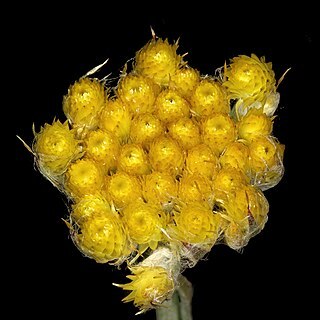Perennial herb; flowering stems up to 400 mm high, erect, loosely grey-woolly, leafy throughout. Leaves in a basal rosette; blade of basal leaves narrowly elliptic or narrowly obovate-oblong, 20-50 x 10-20 mm, apex acute, base broad, clasping, both surfaces loosely grey-woolly; blade of stem leaves smaller, very narrowly ovate to linear. Heads discoid, campanulate, 4-5(-6) mm long, several in a compact, subglobose cluster. Involucral bracts in ± 6 series, subequal, loosely imbricate, exceeding florets, radiating, glossy, bright yellow or deep straw-coloured; outer often overlaid or tipped golden-brown or rarely purple-brown, acute; inner obtuse, apiculate, stereome divided. Receptacle epaleate, with fimbrils exceeding ovaries. Flowers: disc florets only, 30-103; corolla narrowly funnel-shaped, yellow; Dec.-May. Fruit with cypsela (and ovary) glabrous. Pappus of many barbellate bristles, bases cohering by patent cilia.
Flowering stems several, mostly simple, erect, up to ± 400 mm long, loosely grey-woolly, leafy throughout. Leaves: radical leaves ± 20-50 mm long, lanceolate-or oblanceolate-oblong, base broad, both surfaces mostly grey-woolly, upper surface also with coarse patent hairs; cauline leaves erect, smaller upwards, ± lanceolate, shortly decurrent, upper surface sometimes glabrescent. Capitula campanulate, 4-6 mm long, several in compact, subglobose clusters up to ± 30 mm in diam., webbed together; involucral bracts in ± 6 series, glossy, bright yellow or deep straw-coloured, outer often tipped ± brown. Flowers 30-103. Flowering time mainly Dec.-Mar. Pappus of many bristles, apex barbellate. Cypselae 0.75 mm long, barrel-shaped.
Perennial herb, up to 400 mm tall. Radical leaves rosetted, 20-50 x 10-20 mm, lanceolate-oblong or oblanceolate-oblong, both surfaces loosely grey-woolly; cauline leaves smaller, oblong-lanceolate to lanceolate. Heads campanulate, several in a compact subglobose cluster. Flowers yellow; involucral bracts bright yellow or deep straw-coloured, outer often overlaid or tipped golden-brown or rarely, purple-brown.

